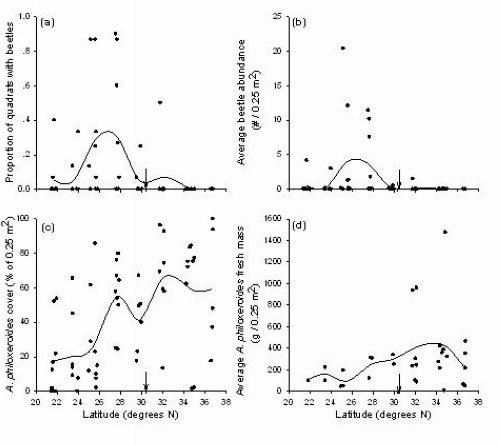Climate change and biological invasions, two major components of global change, significantly affect the environment and quality of life for human. The effects of climate change on the temporal distribution, spatial distribution, and performance of invasive plants have recently received a lot of attention. How climate change shifts the interactions among invasive plants and their natural enemies and thereby biocontrol efficacy however has not been studied yet.
Alternanthera philoxeroides introduced into China in the 1930’s was a worldwide noxious weed. The specialist beetle A. hygrophila was introduced to combat this weed in China in 1986. Previous studies have found that the beetle successfully suppressed A. philoxeroides in aquatic habitats but had no or limited impacts on the plant in terrestrial habitats, partly due to lower pupal survival and high plant tolerance of herbivory in terrestrial habitats. In the past decades, China has experienced increases in air temperature and nitrogen deposition, which may affect the interaction between A. philoxeroides and A. hygrophila and the efforts of bio-control. Thus, studying the impacts of these global changes on the interactions between the two species is of great importance.
In order to invest the impacts of climate warming and nitrogen deposition on the interactions of A. philoxeroides and A. hygrophila, Professor LU Xinmin et al. from Key Laboratory of Aquatic Botany and Watershed Ecology, Wuhan Botanical Garden conducted an extensive field survey in terrestrial habitats along a latitudinal transect from 21.5 °N to 31.8 °N in China and a two-year simulated warming field experiment near the northern limit of the beetle’s distribution.
Field survey showed that the A. hygrophila occurred from 21.5 °N to 31.8 °N, while A. philoxeroides occurred from 21.5°N up to 36.8°N, and performed better at higher latitudes up to 34.5 °N. This difference between the two species resulted in a spatial mismatch between their areas of occurrence and peak abundance. The two-year field experiment showed that the beetle sustained populations across years under elevated temperature, dramatically decreasing A. philoxeroides growth, but it failed to overwinter in ambient temperature, but N deposition had no apparent impacts on the weed, insect and their interaction. Together, these results suggested that warming would allow the natural enemy to expand its range, potentially benefiting biocontrol in regions that were currently too cold for the natural enemy. However, the invader may also expand its range further north in response to warming. In such cases where plants tolerate cold better than their natural enemies, the geographical gap between plant and herbivorous insect ranges may not disappear but would shift to higher latitudes, leading to a new zone of enemy release. Therefore, warming would not only affect plant invasions directly but also drive either enemy release or increase that would result in contrasting effects on invasive plants. The findings are also critical for future management of invasive species under climate change.
Relevant results were published in Global Change Biology (DOI: 10.1111/gcb.12244) entitled “Climate warming affects biological invasions by shifting interactions of plants and herbivores”. This work was funded by the National Science Foundation of China (31100302), US-NSF (DEB 0820560), and the Knowledge Innovation Program of the Chinese Academy of Sciences (KSCX2-YW-Z-1019).

Field survey showing the dependence of (a) beetle occurrence, (b) beetle abundance, (c) A. philoxeroides cover, and (d) A. philoxeroides biomass on latitude (Image by professor LU )
